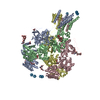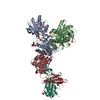[English] 日本語
 Yorodumi
Yorodumi- PDB-6irf: Structure of the human GluN1/GluN2A NMDA receptor in the glutamat... -
+ Open data
Open data
- Basic information
Basic information
| Entry | Database: PDB / ID: 6irf | ||||||||||||||||||
|---|---|---|---|---|---|---|---|---|---|---|---|---|---|---|---|---|---|---|---|
| Title | Structure of the human GluN1/GluN2A NMDA receptor in the glutamate/glycine-bound state at pH 6.3, Class I | ||||||||||||||||||
 Components Components |
| ||||||||||||||||||
 Keywords Keywords | MEMBRANE PROTEIN / ionotropic glutamate receptors / NMDA receptors / synaptic protein | ||||||||||||||||||
| Function / homology |  Function and homology information Function and homology informationglycine-gated cation channel activity / excitatory chemical synaptic transmission / directional locomotion / Synaptic adhesion-like molecules / protein localization to postsynaptic membrane / serotonin metabolic process / response to glycine / propylene metabolic process / sleep / Assembly and cell surface presentation of NMDA receptors ...glycine-gated cation channel activity / excitatory chemical synaptic transmission / directional locomotion / Synaptic adhesion-like molecules / protein localization to postsynaptic membrane / serotonin metabolic process / response to glycine / propylene metabolic process / sleep / Assembly and cell surface presentation of NMDA receptors / regulation of monoatomic cation transmembrane transport / NMDA glutamate receptor activity / Neurexins and neuroligins / NMDA selective glutamate receptor complex / glutamate binding / ligand-gated sodium channel activity / neurotransmitter receptor complex / glutamate receptor signaling pathway / calcium ion transmembrane import into cytosol / protein heterotetramerization / glycine binding / startle response / monoatomic cation transmembrane transport / positive regulation of reactive oxygen species biosynthetic process / dopamine metabolic process / Negative regulation of NMDA receptor-mediated neuronal transmission / Unblocking of NMDA receptors, glutamate binding and activation / positive regulation of calcium ion transport into cytosol / Long-term potentiation / excitatory synapse / monoatomic cation transport / monoatomic ion channel complex / regulation of neuronal synaptic plasticity / positive regulation of excitatory postsynaptic potential / synaptic cleft / positive regulation of synaptic transmission, glutamatergic / calcium ion homeostasis / MECP2 regulates neuronal receptors and channels / glutamate-gated calcium ion channel activity / neurogenesis / EPHB-mediated forward signaling / sensory perception of pain / ionotropic glutamate receptor signaling pathway / Ras activation upon Ca2+ influx through NMDA receptor / sodium ion transmembrane transport / cytoplasmic vesicle membrane / synaptic membrane / response to amphetamine / regulation of membrane potential / transmitter-gated monoatomic ion channel activity involved in regulation of postsynaptic membrane potential / synaptic transmission, glutamatergic / excitatory postsynaptic potential / protein catabolic process / postsynaptic density membrane / brain development / visual learning / regulation of synaptic plasticity / negative regulation of protein catabolic process / calcium ion transmembrane transport / response to wounding / memory / long-term synaptic potentiation / terminal bouton / synaptic vesicle / signaling receptor activity / amyloid-beta binding / presynaptic membrane / RAF/MAP kinase cascade / response to ethanol / dendritic spine / chemical synaptic transmission / postsynaptic membrane / learning or memory / calmodulin binding / neuron projection / postsynaptic density / positive regulation of apoptotic process / response to xenobiotic stimulus / calcium ion binding / synapse / dendrite / endoplasmic reticulum membrane / protein-containing complex binding / glutamatergic synapse / cell surface / positive regulation of transcription by RNA polymerase II / zinc ion binding / plasma membrane / cytoplasm Similarity search - Function | ||||||||||||||||||
| Biological species |  Homo sapiens (human) Homo sapiens (human) | ||||||||||||||||||
| Method | ELECTRON MICROSCOPY / single particle reconstruction / cryo EM / Resolution: 5.1 Å | ||||||||||||||||||
 Authors Authors | Zhang, J. / Chang, S. / Zhang, X. / Zhu, S. | ||||||||||||||||||
| Funding support |  China, 5items China, 5items
| ||||||||||||||||||
 Citation Citation |  Journal: Cell Rep / Year: 2018 Journal: Cell Rep / Year: 2018Title: Structural Basis of the Proton Sensitivity of Human GluN1-GluN2A NMDA Receptors. Authors: Jin-Bao Zhang / Shenghai Chang / Pan Xu / Miao Miao / Hangjun Wu / Youyi Zhang / Tongtong Zhang / Han Wang / Jilin Zhang / Chun Xie / Nan Song / Cheng Luo / Xing Zhang / Shujia Zhu /  Abstract: N-methyl-D-aspartate (NMDA) receptors are critical for synaptic development and plasticity. While glutamate is the primary agonist, protons can modulate NMDA receptor activity at synapses during ...N-methyl-D-aspartate (NMDA) receptors are critical for synaptic development and plasticity. While glutamate is the primary agonist, protons can modulate NMDA receptor activity at synapses during vesicle exocytosis by mechanisms that are unknown. We used cryo-electron microscopy to solve the structures of the human GluN1-GluN2A NMDA receptor at pH 7.8 and pH 6.3. Our structures demonstrate that the proton sensor predominantly resides in the N-terminal domain (NTD) of the GluN2A subunit and reveal the allosteric coupling mechanism between the proton sensor and the channel gate. Under high-pH conditions, the GluN2A-NTD adopts an "open-and-twisted" conformation. However, upon protonation at the lower pH, the GluN2A-NTD transits from an open- to closed-cleft conformation, causing rearrangements between the tetrameric NTDs and agonist-binding domains. The conformational mobility observed in our structures (presumably from protonation) is supported by molecular dynamics simulation. Our findings reveal the structural mechanisms by which protons allosterically inhibit human GluN1-GluN2A receptor activity. | ||||||||||||||||||
| History |
|
- Structure visualization
Structure visualization
| Movie |
 Movie viewer Movie viewer |
|---|---|
| Structure viewer | Molecule:  Molmil Molmil Jmol/JSmol Jmol/JSmol |
- Downloads & links
Downloads & links
- Download
Download
| PDBx/mmCIF format |  6irf.cif.gz 6irf.cif.gz | 538.7 KB | Display |  PDBx/mmCIF format PDBx/mmCIF format |
|---|---|---|---|---|
| PDB format |  pdb6irf.ent.gz pdb6irf.ent.gz | 436.8 KB | Display |  PDB format PDB format |
| PDBx/mmJSON format |  6irf.json.gz 6irf.json.gz | Tree view |  PDBx/mmJSON format PDBx/mmJSON format | |
| Others |  Other downloads Other downloads |
-Validation report
| Summary document |  6irf_validation.pdf.gz 6irf_validation.pdf.gz | 882.2 KB | Display |  wwPDB validaton report wwPDB validaton report |
|---|---|---|---|---|
| Full document |  6irf_full_validation.pdf.gz 6irf_full_validation.pdf.gz | 969.8 KB | Display | |
| Data in XML |  6irf_validation.xml.gz 6irf_validation.xml.gz | 91.9 KB | Display | |
| Data in CIF |  6irf_validation.cif.gz 6irf_validation.cif.gz | 135.7 KB | Display | |
| Arichive directory |  https://data.pdbj.org/pub/pdb/validation_reports/ir/6irf https://data.pdbj.org/pub/pdb/validation_reports/ir/6irf ftp://data.pdbj.org/pub/pdb/validation_reports/ir/6irf ftp://data.pdbj.org/pub/pdb/validation_reports/ir/6irf | HTTPS FTP |
-Related structure data
| Related structure data |  9715MC  9714C  9716C  9717C  6iraC  6irgC  6irhC M: map data used to model this data C: citing same article ( |
|---|---|
| Similar structure data |
- Links
Links
- Assembly
Assembly
| Deposited unit | 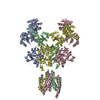
|
|---|---|
| 1 |
|
- Components
Components
| #1: Protein | Mass: 95336.219 Da / Num. of mol.: 2 / Mutation: G612R Source method: isolated from a genetically manipulated source Details: 2 mM Glycine / Source: (gene. exp.)  Homo sapiens (human) / Gene: Grin1, NMDAR1 / Cell line (production host): HEK293S GnTl- / Production host: Homo sapiens (human) / Gene: Grin1, NMDAR1 / Cell line (production host): HEK293S GnTl- / Production host:  Homo sapiens (human) / References: UniProt: Q05586 Homo sapiens (human) / References: UniProt: Q05586#2: Protein | Mass: 94192.172 Da / Num. of mol.: 2 / Mutation: E656R, E657R Source method: isolated from a genetically manipulated source Details: 2 mM L-Glutamate / Source: (gene. exp.)  Homo sapiens (human) / Gene: Grin2a / Cell line (production host): HEK293S GnTl- / Production host: Homo sapiens (human) / Gene: Grin2a / Cell line (production host): HEK293S GnTl- / Production host:  Homo sapiens (human) / References: UniProt: Q12879 Homo sapiens (human) / References: UniProt: Q12879Has protein modification | Y | |
|---|
-Experimental details
-Experiment
| Experiment | Method: ELECTRON MICROSCOPY |
|---|---|
| EM experiment | Aggregation state: PARTICLE / 3D reconstruction method: single particle reconstruction |
- Sample preparation
Sample preparation
| Component | Name: Human GluN1/GluN2A NMDA receptors in the glutamate/glycine bound state at pH 6.3, Class I Type: COMPLEX / Details: with the presence of Glycine,L-glutamate and EDTA / Entity ID: all / Source: RECOMBINANT | |||||||||||||||||||||||||||||||||||||||||||||
|---|---|---|---|---|---|---|---|---|---|---|---|---|---|---|---|---|---|---|---|---|---|---|---|---|---|---|---|---|---|---|---|---|---|---|---|---|---|---|---|---|---|---|---|---|---|---|
| Molecular weight | Value: 0.38 MDa / Experimental value: NO | |||||||||||||||||||||||||||||||||||||||||||||
| Source (natural) | Organism:  Homo sapiens (human) Homo sapiens (human) | |||||||||||||||||||||||||||||||||||||||||||||
| Source (recombinant) | Organism:  Homo sapiens (human) / Cell: HEK293S GnTl- / Plasmid: pEG-Bacmam Homo sapiens (human) / Cell: HEK293S GnTl- / Plasmid: pEG-Bacmam | |||||||||||||||||||||||||||||||||||||||||||||
| Buffer solution | pH: 6.3 / Details: Solutions were made fresh. | |||||||||||||||||||||||||||||||||||||||||||||
| Buffer component |
| |||||||||||||||||||||||||||||||||||||||||||||
| Specimen | Conc.: 3.5 mg/ml / Embedding applied: NO / Shadowing applied: NO / Staining applied: NO / Vitrification applied: YES / Details: Tetrameric GluN1/GluN2A NMDA receptors | |||||||||||||||||||||||||||||||||||||||||||||
| Specimen support | Details: 15 mA / Grid material: GOLD / Grid mesh size: 200 divisions/in. / Grid type: Quantifoil R1.2/1.3 | |||||||||||||||||||||||||||||||||||||||||||||
| Vitrification | Instrument: FEI VITROBOT MARK II / Cryogen name: ETHANE / Humidity: 100 % / Chamber temperature: 291 K Details: blot for 2 seconds before plunging in liquid ethane |
- Electron microscopy imaging
Electron microscopy imaging
| Experimental equipment |  Model: Titan Krios / Image courtesy: FEI Company |
|---|---|
| Microscopy | Model: FEI TITAN KRIOS |
| Electron gun | Electron source:  FIELD EMISSION GUN / Accelerating voltage: 300 kV / Illumination mode: FLOOD BEAM FIELD EMISSION GUN / Accelerating voltage: 300 kV / Illumination mode: FLOOD BEAM |
| Electron lens | Mode: BRIGHT FIELD |
| Image recording | Average exposure time: 12 sec. / Electron dose: 56 e/Å2 / Film or detector model: GATAN K2 SUMMIT (4k x 4k) / Num. of grids imaged: 4 |
| Image scans | Movie frames/image: 40 / Used frames/image: 1-40 |
- Processing
Processing
| EM software |
| ||||||||||||||||||||||||||||||||||||||||
|---|---|---|---|---|---|---|---|---|---|---|---|---|---|---|---|---|---|---|---|---|---|---|---|---|---|---|---|---|---|---|---|---|---|---|---|---|---|---|---|---|---|
| CTF correction | Type: PHASE FLIPPING AND AMPLITUDE CORRECTION | ||||||||||||||||||||||||||||||||||||||||
| Particle selection | Num. of particles selected: 722287 | ||||||||||||||||||||||||||||||||||||||||
| 3D reconstruction | Resolution: 5.1 Å / Resolution method: FSC 0.143 CUT-OFF / Num. of particles: 193878 / Symmetry type: POINT | ||||||||||||||||||||||||||||||||||||||||
| Atomic model building | Protocol: RIGID BODY FIT | ||||||||||||||||||||||||||||||||||||||||
| Atomic model building | 3D fitting-ID: 1 / Source name: PDB / Type: experimental model
|
 Movie
Movie Controller
Controller


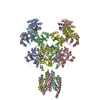
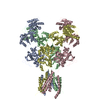

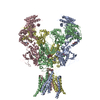

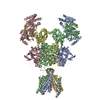
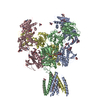

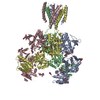
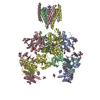
 PDBj
PDBj












